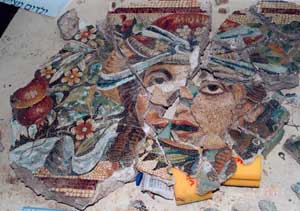|
HOME | SEARCH | ARCHIVE |
|
Early
Greek temple found in Israel by Berkeley archaeologist
Discovery opens
window on Jewish history at a turbulent site
| |
 Berkeley archaeologists uncovered a Greek floor mosaic in northern Israel dating from about the second century B.C.., the earliest evidence of substantial Geeek habitation in Israel. |
By Patricia McBroom, Public Affairs
14 February 2001 | The earliest evidence of a Greek temple in Israel has been discovered by a Berkeley archaeologist in excavations of a northern port city that was once King Solomon's harbor on the Mediterranean Sea.
The find at Tel Dor, 25 miles south of Haifa, dates to the first or second century B.C. It pushes back evidence of a major Greek presence in Palestine and surrounding territories by 200 years, said Andrew Stewart, Berkeley professor of art history and classics.
Along with Greek temple columns and fragments of the superstructure, Stewart found a headless statue of the Greek winged goddess Victory (Nike, in Greek) and a beautiful section of floor mosaic depicting women wearing hats full of flowers and fruits. Restoration of the artifacts, discovered in August, have now been completed.
All of the discoveries were dug from pits where they had been discarded in ancient times to create the foundation for another building. This evidence of destruction leads Stewart to believe the temple was dismantled in a revival of Jewish traditionalism at Dor that occurred briefly in 100 or 99 B.C., when the Jewish king, Alexander Jannaeus, took control of the city.
"This was part of a crusade by the Hasmonean dynasty to wipe out all pagan symbols, to clean the slate after two centuries of paganism," said Stewart. "If we are right about the date of this deposit, this is the first evidence of the Hasmonean destruction of pagan shrines and a direct link with Jewish history."
This period of history is contained in the Book of Maccabees that follows the end of the Bible's Old Testament and in the writings of the Jewish historian Flavius Josephus.
A sizeable city of up to 25,000 people in its heyday and mentioned many times in the Old Testament, Dor is now a tall mound of desposits about 75 feet high and 75 acres in expanse, projecting into the Mediterranean. It contains the remains of almost every civilization that ever passed through the Middle East, beginning with the Canaanites who established the city in 2000 B.C.
At various times, Dor was controlled by the Egyptians, Sikils, Phoenicians, Israelites, Assyrians, Persians, Greeks and Romans. It is currently under Israeli control. But, because of its ancient location on Israel's northern border, it never stayed long in Jewish hands, said Stewart.
King David may have conquered Dor around 1,000 B.C., after which it became Solomon's main port on the Mediterranean. Solomon tucked the city into a dowry for his daughter, and it was part of the northern kingdom of Israel until it was sacked by the Assyrians in 732 B.C.
The city changed hands every two or three centuries after that. It was completely abandoned in Roman times around 235 A.D., never to rise again.
"The Romans spent enormous amounts of time and money building two huge temple complexes at Dor and then just walked away from them. And we have no idea why," said Stewart.
The Greeks controlled Dor twice, in the mid fifth century B.C. and during the Hellenistic period that began in 332 B.C., after Alexander the Great conquered the Middle East. Pottery and coins testify to Greek influence, but without evidence of habitation, there had been no way to prove whether many Greeks actually lived there.
Stewart's discovery of the temple columns now provides that evidence, pointing to a substantial community of settlers. "This adds a new chapter to Greek art and architecture," said Stewart. "No one had found Greek architecture and sculpture like this in Israel before. Now we have it."
The statue of Nike, about two feet high, would have stood at the corner of the temple, on top of the pediment, Stewart said.
It is not known whether the mosaic section he found is from the Greek temple, or some other building. Nor is it likely that any archaeologist will soon find out. Only three percent of the incredibly rich site has been excavated, and Stewart has no idea where the temple's foundation is located.
He hopes to return to Tel Dor again in the summer of 2003 with 30 to 50 volunteers from the Bay Area and elsewhere. Unlike most countries with deposits from ancient civilizations, Israel allows excavation by volunteers rather than by paid workers; Stewart has taken some 400 volunteers to Tel Dor over the years.
"We train them, and they do the digging," he said. "I take anyone between the ages of 18 and 80 who's fit and willing to work."
Home | Search | Archive | About | Contact | More News
Copyright 2001, The Regents of the University of California.
Produced and maintained by the Office of Public Affairs at UC Berkeley.
Comments? E-mail berkeleyan@pa.urel.berkeley.edu.